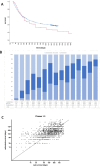How accurate is clinical prognostication by oncologists during routine practice in a general hospital and can it be improved by a specific prognosis training programme: a prospective interventional study
- PMID: 38890134
- PMCID: PMC11191806
- DOI: 10.1136/bmjopen-2023-081661
How accurate is clinical prognostication by oncologists during routine practice in a general hospital and can it be improved by a specific prognosis training programme: a prospective interventional study
Abstract
Objectives: Oncologists need competence in clinical prognostication to deliver appropriate care to patients with cancer. Most studies on prognostication have been restricted to patients in palliative care settings. This paper investigates (1) the prognostic accuracy of physicians regarding a broad cohort of patients with cancer with a median life expectancy of >2 years and (2) whether a prognosis training can improve prognostication.
Design: Prospective single-centre study comprising 3 phases, each lasting 1 month.
Setting: Large teaching hospital, department of oncology and haematology, Germany.
Participants: 18 physicians with a professional experience from entry level to 34 years. 736 patients with oncological and malignant haematological diseases.
Interventions: Baseline prognostication abilities were recorded during an 'untrained' phase 1. As an intervention, a specific prognosis-training programme was implemented prior to phases 2 and 3. In phase 3, physicians had to provide additional estimates with the inclusion of electronic prognostic tools.
Outcome measures: Prognostic estimates (PE) were collected using 'standard' surprise question (SQ), 'probabilistic' SQ (both for short-term prognostication up to 6 months) and clinician prediction of survival (CPS) (for long-term prognostication). Estimated prognoses were compared with observed survival. Phase 1 was compared with phases 2 and 3.
Results: We included 2427 PE for SQ, 1506 for CPS and 800 for probabilistic SQ. Median OS was 2.5 years. SQ accuracy improved significantly (p<0.001) from 72.6% in phase 1 to 84.3% in phase 3. Probabilistic SQ in phase 3 showed 83.1% accuracy. CPS accuracy was 25.9% and could not be significantly improved. (Electronic) prognostic tools-used alone-performed significantly worse (p<0.0005) than physicians and-used by the clinicians-did not improve their performance.
Conclusion: A specific prognosis-training programme could improve short-term and intermediate-term prognostication. Improvement of long-term prognostication was not possible. Inexperienced residents as well as experienced oncologists benefited from training.
Keywords: education & training (see medical education & training); oncology; prognosis.
© Author(s) (or their employer(s)) 2024. Re-use permitted under CC BY-NC. No commercial re-use. See rights and permissions. Published by BMJ.
Conflict of interest statement
Competing interests: None declared.
Figures


References
Publication types
MeSH terms
LinkOut - more resources
Full Text Sources
Medical
Research Materials
